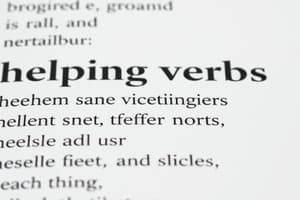Podcast
Questions and Answers
Which of the following is NOT a helping verb?
Which of the following is NOT a helping verb?
- does
- have
- go (correct)
- was
Which of the following forms of 'to have' is used for the third person singular?
Which of the following forms of 'to have' is used for the third person singular?
- have
- had
- has (correct)
- haves
Which helping verb is used when forming the past tense for actions?
Which helping verb is used when forming the past tense for actions?
- are
- were (correct)
- am
- does
Identify the helping verb that is used to express an action that has already been completed.
Identify the helping verb that is used to express an action that has already been completed.
What is the simple past form of the helping verb 'to do'?
What is the simple past form of the helping verb 'to do'?
Flashcards are hidden until you start studying
Study Notes
Helping Verbs Overview
- Helping verbs, also known as auxiliary verbs, support the main verb in a sentence to convey tense, mood, or voice.
- Common examples include "is," "am," "are," "have," "has," "do," "does," and "will."
Identification of Helping Verbs
- "Do" is not classified as a helping verb; it functions as a main verb and can stand alone in sentences.
Forms of 'To Have'
- "Has" is the form of 'to have' used for third-person singular subjects (he, she, it).
Past Tense Formation
- "Was" or "were" serve as helping verbs to form the past tense for actions, depending on the subject (singular or plural).
Expressing Completed Actions
- The helping verb "has" is used to express actions that have already been completed, particularly in the present perfect tense.
Simple Past of 'To Do'
- The simple past form of the helping verb "to do" is "did."
Studying That Suits You
Use AI to generate personalized quizzes and flashcards to suit your learning preferences.




